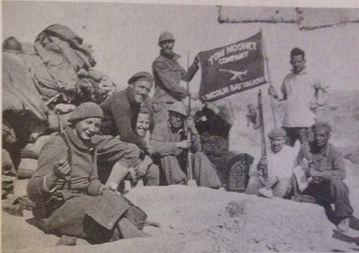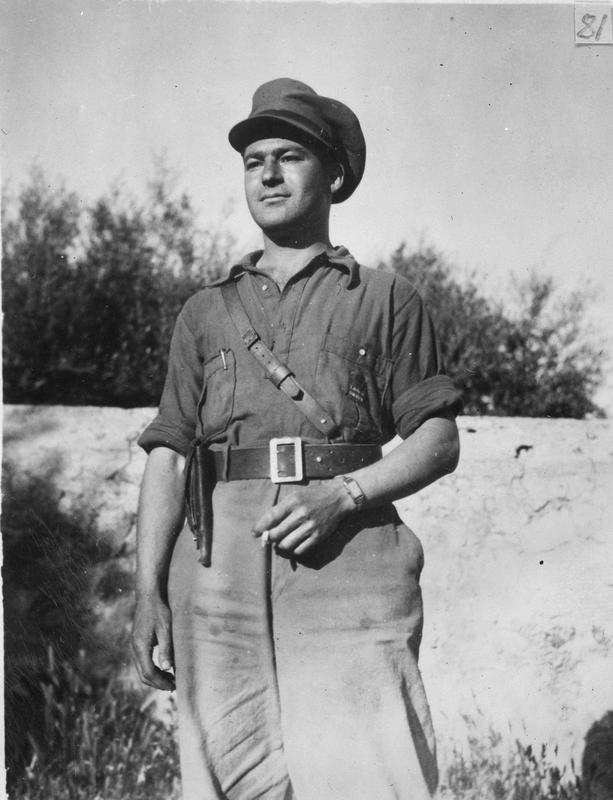
Action heated up at Villaneuva de la Jara over the next two days. Leaders for the new Lincoln Companies were chosen. John Scott, whose real name was Inver Marlow, was made commander of Company #1, which included the Connolly Column, a group of Irish volunteers who preferred to be in the Lincolns rather than staying with the British Battalion. While the Irish may have separated themselves from the British, Scott himself was British and the friction between him and the Connolly column would show later. The #2 company was placed under American Steve Daduk, who was reputed to have been a pilot in Madrid earlier in 1936. Landis says that Daduk’s exploits as a pilot were verified¹ but questions over his background were part of the difficulties with Merriman. The third Machine Gun Company was led by Douglas Seacord. Landis points out that the Company only had two machine guns, an old French Hotchkiss and a Chauchot, both of which were worn down so much no one knew where the bullets were going to go. Landis says¹:
“The Machine Gun Company with, or without its guns, gives an indication of the background and thinking of its members, for they had proudly elected to call themselves the Tom Mooney Company after American labor leader Thomas Mooney, who , at that very moment, was serving a life sentence in Alcatraz Federal Prison.”
A photograph of the Tom Mooney Machine Gun Company can be found in Carroll² from Box 1 Folder 17 of the Paul Burns collection at Tamiment (ALBA Photo 184). One gunner in the Company said “We behaved like a bunch of anarchists, but we loved that man {Seacord}”³.

On the 30th, Merriman’s challenges arose with an impromptu meeting with Stember, Eugene Morse, Al Tanz and John Scott. Apparently his lecture brought out the unpreparedness of the men. “Steve had talked to Scott about bad front, slaughter house and watching me” is very cryptic. Daduk was reputed to have expertise at the front from Fall 1936 and he may have been referring to the Madrid front being dangerous for untrained troops. There is no aid in interpreting this event from Marion Merriman Wachtel’s memoir. Obviously, Daduk was making charges about Merriman and there was a suggestion that Merriman was a Russian plant, since he had come to Spain via Moscow. The “charges” made by Daduk against Merriman were run by the American leadership and the British who were at Madrigueras (Frank Ryan, Tom Wintringham and Wilfred Macartney). Macartney, the British Battalion commander, was described ungraciously by Eby as a “paunchy grandboulevardier, who, even in Spain, drank nothing other than good champagne and bottled water.” Hugh Thomas notes in a footnote “The leader of the English Battalion in training had been Wilfred Macartney, a flamboyant journalist of the Left who was not a Communist – though he had been to prison for giving military secrets to Russia. Already a rich man, he had grown richer on the profits of the book he then wrote on his experiences, Walls Have Mouths, published in 1935, after leaving prison, with an introduction by Compton Mackenzie. He had to abandon command of the Brigade because he was shot in the leg by Peter Kerrigan, Commissar of all the British in Spain, who was apparently merely cleaning his gun”.4
The other two names mentioned here were Eugene Morse, the head of the Supply Depot and Al Tanz, who was the Quartermaster. Tanz’s biography photo is shown here.

Merriman finishes by introducing the English Captain Douglas (Dave) F. Springhall and Captain George Montague Nathan, the British Chief of Staff. The rifles of which Merriman speaks are new, dated 1936. Many of the Lincolns went into action with “Mexicanskis” which were rifles made for the Russian war against the White Russians and which were sold to Mexico. They came from Mexico but had the Winchester imprints of the Russian Imperial Army and were vintage 1917.
At the end, Merriman notes that the charges against him by Daduk were shown to be false and ultimately this event contributed to Daduk’s demise in the Battalion.
_____________________________
¹ Landis, The Abraham Lincoln Brigade, ibid.
² Carroll, Odyssey, ibid. (photo section after page 5)
³ Eby, Comrades and Commissars, ibid., p49
4 Hugh Thomas, The Spanish Civil War, Harper and Brothers, New York, 1961, pp. 376-7.
